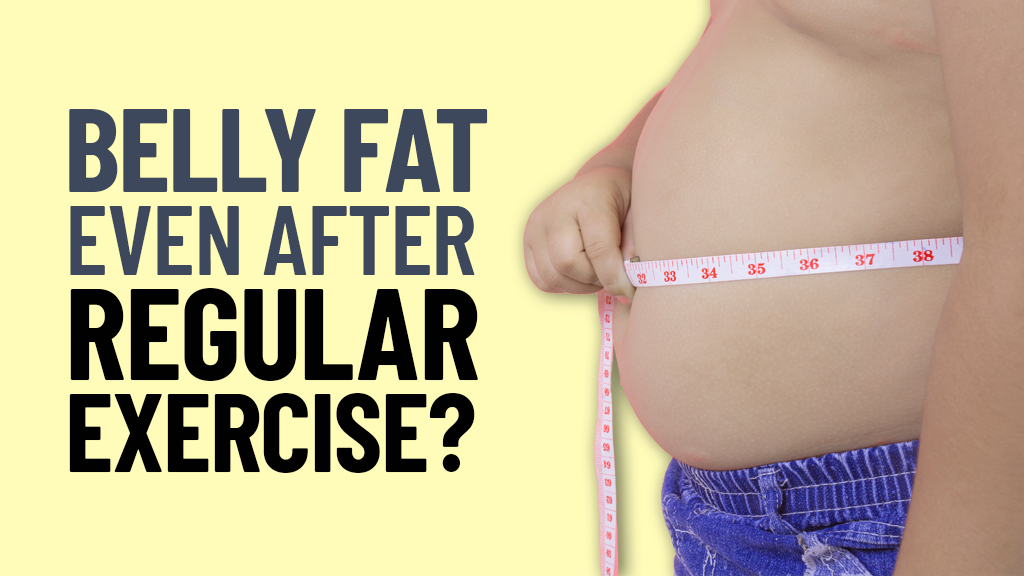
Belly fat even after regular exercise?

Losing abdominal or belly fat may be a growing concern for most people. Some people think of exercise as a solution, and others get busy with trying devices like sauna belts, slimming gels, etc. to get a flat stomach. Regardless of all these efforts, you may have observed that people who exercise tend to still have a pot-belly. Why is that the case?
There are several reasons why fat tends to accumulate around the belly like age, genetics, exercise, and diet. So, let us see what science has to say on why belly fat continues to develop even as you exercise, and why it takes time to shed that fat.
Why is Belly fat so stubborn?
Fat around the belly occurs because of the same reason you build up fat anywhere on your body. The calories you eat from food are used as energy to fuel your regular body functions, from digesting your food to completing physical activity. If there are excess calories left, your body will store them as fat in the fat cells of your body.
You can’t release fat from the fat cells from any part of your body unless you burn more calories than you consume. Moreover, it’s difficult to reduce fat from your belly section because it has a higher amount of fat cells that respond slowly to the fat breakdown process. So when you lose weight, you may observe that losing weight from the stomach area is slower than in other parts of the body.
Now, most of the fat in our body gets stored below our skin(subcutaneous fat) while the other, visceral fat is stored deep inside the belly surrounding different internal organs like the liver, kidneys, etc. While neither of them is good for your health, a higher amount of visceral fat may lead to many health problems like cholesterol, diabetes, and heart diseases. This is because excess fat releases fatty acids into your blood which increases the fat content in your blood, increasing your blood sugar levels and leading to health problems like Cholesterol, Diabetes, and eventually heart diseases.
Also Read: Where do you lose fat from first?
How to reduce belly fat?
To reduce fat, you need to use fat as an energy source. However, our body’s preferred source of energy is carbohydrates that we get from the food we eat. During exercise, if your body has enough carb or glycogen, it will use only that for energy and not shift to fat as an energy source. However, if there is not enough carbs in your body, the fat will be used as an energy source. It will be transported to your muscle cells through the blood where it will be used to support your workout. Therefore, a calorie deficit is the key to fat loss.
However, in reality, many do the opposite. You may work hard while exercising but all that hard work goes for a toss when you treat yourself with a high calorie meal. For instance, after your daily walk, you go on to eat your favorite vada pav with tea. Now, on average you burn 100-200kcal during your 30min walk. However, adding on a vada pav(206kcal) and cup of tea (60kcal), you consume almost 260 kcal. The extra calories get stored as fat and eventually the fat percentage increases when this becomes a continuous habit.
Also Read: Can I lose belly fat by walking
Tips to reduce belly fat
While losing belly fat is not only good for your physical appearance but can protect you from various health diseases. It’s important to understand that to reduce belly fat or any other fat in your body, it’s important that your body uses fat as energy. This is possible when you move more and eat less to bring your weight under control. Here are some tips you can follow to reduce your belly fat:
Eat right: Reduce your calorie intake by 10-25%. This means that try eating less than your usual quantity. For instance, if you are eating 100gm rice every day, reduce it to 80gm. Add more fiber and protein to your diet. In addition to this, avoid highly processed foods like chips and cold drinks as they are usually high in calories.
Stay active through the day: Try to exercise regularly and consistently. You can incorporate different types of training like aerobic, and strength training to challenge your body. Additionally, it is important to move through the day and not only limit it to the workouts.
Avoid eating 3-4 hours before your workout: This will deplete your glycogen reserve and then your body will use fat as energy to fuel your exercise.
Increase aerobic activities and strength training: A combination of aerobic exercises like walking, and running along with strength training like lifting weights or bodyweight exercises will help to lose fat faster. Consume protein: On average, you should consume at least 1gm of protein per kg of your body weight. Say if you are 60kg, you should consume at least 60gm protein throughout the day. This will help to convert your fat into muscles at a faster rate when you exercise and also reduce your hunger cravings throughout the day.














